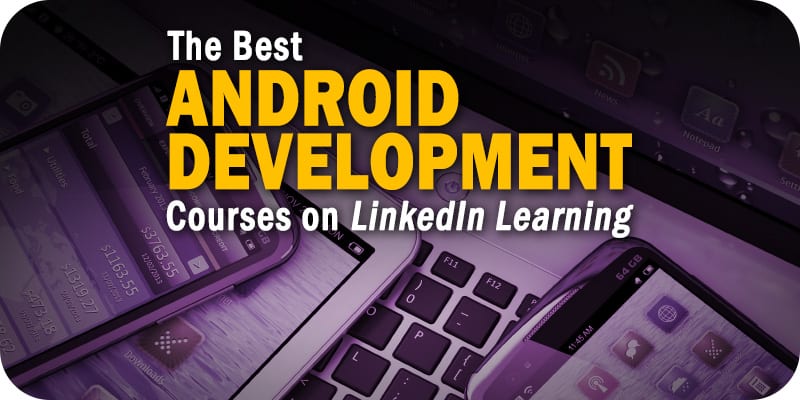The 4 Best Android Development Courses on LinkedIn Learning

 Solutions Review compiled the top Android development courses on LinkedIn Learning for mobile professionals of all skill levels.
Solutions Review compiled the top Android development courses on LinkedIn Learning for mobile professionals of all skill levels.
 Mobile application development continues to be a hot topic among mobile and IT professionals, especially at larger companies that have the resources to create their own application infrastructure. Learning the essential skills of Android development is a necessity for mobile app development and design professionals. Online courses and training are great resources who those who want to learn more about Android development.
Mobile application development continues to be a hot topic among mobile and IT professionals, especially at larger companies that have the resources to create their own application infrastructure. Learning the essential skills of Android development is a necessity for mobile app development and design professionals. Online courses and training are great resources who those who want to learn more about Android development.
With this in mind, the editors at Solutions Review have compiled this list of top-rated Android development on LinkedIn Learning to consider taking. Each course in its catalog is taught by industry experts in software, technology, and business skills. Courses are listed in no particular order.
4 Android Development Courses on LinkedIn Learning
Course Title: Android Studio Essential Training 2020
OUR TAKE: With over 30 years of experience as a software developer and architect, technical trainer, author of technical books, and curriculum developer, David Gassner covers all the basics of installation, project creation, testing, and customization through Android Studio.
Description: Software developers who want to build Android apps need Android Studio—the official Google IDE. Android Studio is based on IntelliJ IDEA and contains the same great coding and debugging features plus lots of tools that are unique to Android development: layout editors, resource managers, virtual device support, and more. In this course, instructor David Gassner introduces Android Studio. He helps you set up your environment and your first project and provides handy shortcuts for writing and debugging code. You can also learn how to add version control and share projects on GitHub, manage project dependencies, use templates, and work with Google’s preferred programming language for Android development, Kotlin. By the end of the course, you should be able to use Android Studio to become a faster, even more efficient developer.
Course Title: Kotlin Essential Training
OUR TAKE: Course author Troy Miles (AKA the Rockncoder) is an award-winning software developer, speaker, and author with decades of experience. This course covers working with variables and functions, creating classes, and working with companion objects in Kotlin.
Description: Kotlin, the powerful programming language from JetBrains, offers null safety, concise syntax, and 100% Java compatibility. Plus, it’s fully supported by Google for Android development. If you’re looking to get up and running with this popular language, then this course is for you. Join instructor Troy Miles as he provides a comprehensive overview of what developers need to create command-line programs using the Kotlin programming language. Troy starts by covering the basics: data types and variables, how statements differ from expressions, and what the different types of expressions are. He then dives into all of the language’s essential features, from functions and classes to coroutines, as well as how to effectively debug your Kotlin code.
Course Title: Android Development Essential Training: Your First App
OUR TAKE: Senior Director of Engineering at Meetup and noted Linked Learning author Annyce Davis talks about setting up Android Studio, creating virtual devices, exploring project structure, troubleshooting projects, and implementing designs in XML layouts.
Description: Android is the most popular mobile operating system in the world, holding 85% of global market share. That makes Android the natural starting point for new app developers. This series of courses teaches the basics needed to develop, design, manage, and distribute a native Android application using the Kotlin programming language and the Android SDK. Part 1 covers setting up your development environment—on Mac or Windows—including Android Studio and the physical or virtual devices you’ll need for testing. Instructor Annyce Davis then explores the structure of a typical Android app as well as the build files, dependencies (external code and libraries used in your project), and prebuilt components available from third-party providers like Jetpack. In the fourth chapter, she pivots to active development, demonstrating how to define the screens of your user interface using activities, XML layouts, and Views. Make sure to take the challenges throughout the course to practice your new skills.
Course Title: Android App Development: Design Patterns for Mobile Architecture
OUR TAKE: As a Staff Software Engineer at Twitter and contracted author at LinkedIn Learning, Jonathan Bott takes students through the basics of Android app development, including common architectures, expanding layers, working with entities, and binding with RxJava.
Description: Developers need to know how to manage an app’s complexity. In this course, learn how to simplify your apps by applying simple architectural design patterns to your mobile codebase. Discover how these design patterns can help you reduce bugs and maximize your development time by making your code easier to read and test. Jon Bott covers different architectural models such as MVC, MVP, and VIPER. In addition, he walks through the conversion process from MVC to a layered architecture, covering dependency injection, the coordinator pattern, and data binding.
Solutions Review participates in affiliate programs. We may make a small commission from products purchased through this resource.
Looking for more info on the benefits of mobility management? You should check out our free Mobility Management Buyer’s Guide. We profile the top vendors in the mobility management field, list their key capabilities, and determine our Bottom Line for each.
Check us out on Twitter for the latest in Enterprise Mobility news and developments!




















